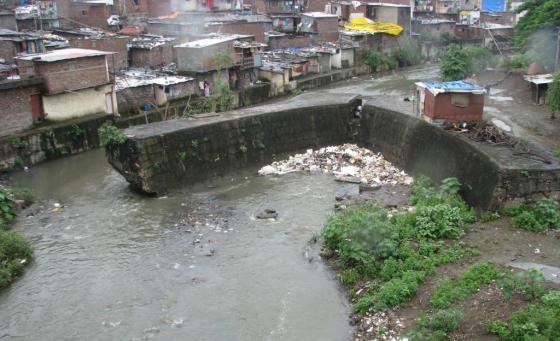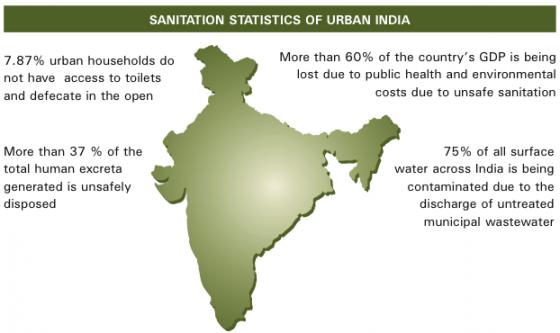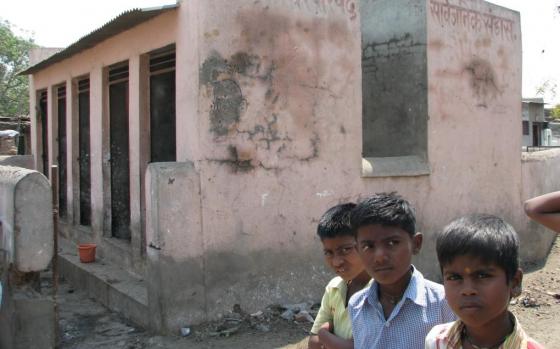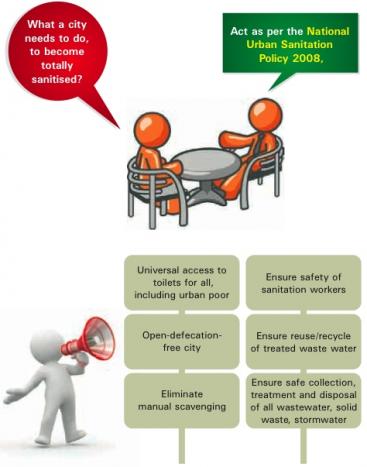المُلخص التنفيذي
| Disclaimer: Links within the texts to additional information, concepts and tools are SSWM editor’s inputs and might not represent the view or practices of GIZ. |
Welcome to Incredible India!
India is a huge and diverse country with an estimated population of 1.22 billion people (INDIASTAT 2012), a population growth rate of 1.3% per annum (CIA 2012) and an incredible diversity of wealth, religion, language, customs, art, cuisine and landscape. India is projected to surpass the population of China and become the most populated country by 2021, with an estimated population of 1.69 billion inhabitants by 2050 (UN 2011).

Incredible India. Source: L. BARRETO DILLON (2012)
India is one of the fastest growing major economy in the world, with a GDP real growth rate of 7.2% in 2011 (CIA 2012). It is estimated that more than half of the Indian labour force is in agriculture, but it contributes only 17.2% to its GDP. However, the growing services sector, that only employs about 34% of the workforce, accounts for 56.4% of the country’s GDP, and therefore it is increasingly playing an important role of India's economy (CIA 2012).
Mumbai, growing metropolis in India. Source: L. BARRETO DILLON (2009)
Thanks to its large educated English-speaking population, India is now a major provider of Information Technology, transforming the country into an important centre of global outsourcing of customer services and technical support. Furthermore, this sector is complemented with other business such as manufacturing, pharmaceuticals, biotechnology, nanotechnology, telecommunication, shipbuilding, aviation and tourism.
A Sanitation Policy Specially for Urban Areas
Although in 2008 about 30% (340 million) of India’s people lived in cities and towns, these areas generated over 58% of the country’s GDP. As a result of this high economic power, most towns and cities have expanded rapidly, with thousand of people from rural areas migrating daily in search of economic opportunities. In the future, Indian cities will play an even more critical role. According to a study carried out by the McKinsey Global Institute (SANKHE et al. 2010), urban India will generate 70% of new jobs created until 2030, produce around 70% of the country’s GDP in 2030 and around 85% of total tax revenues. This incredible growth and the proliferation of employment opportunities will be a powerful magnet, increasing the urban population from 360 million in 2012 to 590 million in 2030.

Untreated sewage water in Mumbai, India. Source: L. BARRETO DILLON (2009)
The rapid urbanisation and the alarming predictions for the future, pose an unprecedented challenge for Indian cities, which still fail to deliver a basic standard of living for their residents. According to the last census in 2011, only 72.6% of the households in urban areas had access to a water closet (see also access to water and sanitation), of which only the 32.7% were connected to a piped sewer system (data from GOI 2012). The installed sewage treatment capacity is actually only 30%. Furthermore, it is estimated that more than 30 million households are connected to a septic tanks, however the sludge management (e.g. sludge treatment) continue to be disregarded in most of the cities and towns. This situation has detrimental effects on the quality of water resources, to the point that today 75% of all invalid link across India is contaminated (MOUD 2008) (see also water pollution, pathogens and contaminants, invalid link).

Sanitation statistics of urban India. Source: GIZ (2011)
The living conditions of the urban poor in India are more alarming. The 42.6 million of people living in slums in cities and towns (with a population of 50'000 and above) are forced to subsist in overcrowded conditions, often polluted and with a lacking of basic civic amenities like clean drinking water, sanitation and health facilities (see also access to water and sanitation, right to water and sanitation). A total of 54.7 % of urban slums have no toilet facility and most free community toilets built by state government or local bodies are rendered unusable because of the lack of maintenance.

Latrines in bad conditions in Indian slums. Source: L. BARRETO DILLON (2010)
NUSP: A Response to the Crisis
With the aim of improving the sanitation situation in urban areas, the Government of India (GoI) sanctioned a policy paper prepared by the Ministry of Urban Development (MoUD) as the National Urban Sanitation Policy (NUSP). This document outlines the following aspirational sanitation vision for Indian cities (MOUD 2008):
“All Indian cities and towns should become totally sanitised, healthy and liveable and ensure and sustain good public health and environmental outcomes for all their citizens with a special focus on hygienic and affordable sanitation facilities for the urban poor and women.”
The NUSP defines sanitation as “safe management of human excreta, including its safe confinement treatment, disposal and associated hygiene-related practices” (MOUD 2008). It further recognises that integral solutions are needed to take account of other elements of environmental sanitation, such as solid waste management, generation of industrial and other specialised and hazardous wastes, drainage (e.g. stormwater management) and management of drinking water supply (see also sustainable sanitation and the chapters wastewater collection, water purification and water distribution).
In order to achieve the vision of NUSP, a set of key policy issues are pointed out that should be addressed by the different governments: poor awareness about the linkages between sanitation and public health; persistence of manual scavenging; gaps and overlaps in institutional roles and responsibilities at the national, state, and city levels; lack of an integrated city-wide approach when planning and implementing sanitation measures; limited technology choices; constrained access to sanitation facilities for the un-served and the poor; and lack of demand responsiveness.
In the NUSP, the GoI recognises that sanitation is a state subject and calls all State Governments in India to prepare State Level Sanitation Strategies and Urban Local Bodies (ULB) to prepare City Sanitation Plans. The NUSP is a comprehensive framework that not only defines the specific goals to be attained, but also indicates how the GoI will be supporting the states in developing and implementing innovative strategies to accord priority to urban sanitation. Furthermore, it presents three Annexures with clear instructions to State Governments and Urban Local Bodies, on how to develop their regional strategies:
Goals of the National Urban Sanitation Policy of India
The overall goal of this policy is to transform urban areas in India into community-driven, totally sanitised, healthy and liveable cities and towns (MOUD 2012). According to this definition a fully sanitised city should have:
- Communities and institutions aware about sanitation and its linkages with public and environmental health.
- Men, women, boys and girls who have changed their behaviour and have adopted healthy sanitation practices.
- All urban dwellers with access to safe and hygienic sanitation facilities and arrangements, so that no one defecates in the open.
- All sectors and departments manage sanitation as a cross-cutting issue, planning and implementing measures in a coordinated way.
- Strengthened national, state, city and local institutions (public, private and community), capable of planning, implementing, operate and maintain sanitation facilities.
- 100% of human excreta and liquid wastes from all sanitation facilities including toilets are disposed off safely.
- Treated wastewater is recycled and reused for non-potable applications.
- All household, community and public sanitation facilities are properly used, monitored and maintained.

The National Urban Sanitation Policy 2008. Source: GIZ (2011)
Therefore, the National Urban Sanitation Policy calls for a complete change of paradigm, in which the focus should not only be given to large infrastructure projects, but instead a significant effort has to be done to developing the human capital through awareness creation, behavioural change programmes, institutional strengthening and re-structuring (see also creating an enabling environment and developing human resources in water supply). The specific goals of the NUSP are therefore:
- To generate awareness regarding sanitation and behaviour change among citizens (see also awareness raising in water supply or awareness raising in wastewater treatment or demand creation tools).
- To achieve 100% open defecation free cities.
- To mainstreaming sanitation with re-oriented and strengthening human resources (see also strengthening enforcement bodies in water supply or invalid link).
- To achieve 100% sanitary and safe disposal of human excreta and liquid waste.
- To ensure proper operation and maintenance of all sanitary installations (see also ensuring sustainability).
Strategy of the Government of India to Support States for the Implementation
Besides requesting all states to act at par with the NUSP, this document serves as a guideline to State Governments as well as Urban Local Bodies in how to go about when defining sanitation strategies and plans, outlining core building blocks to assist in the thinking through the challenge. However, it is recognised that “although there are some common elements across urban areas of India, there are a number of factors, constraints and opportunities that are peculiar to specific situation of states and cities with respect to sanitation, climate, physiographic factors, economic, social and political parameters, and institutional variables. Therefore, each state and city is requested to formulate its own sanitation strategy and their respective city sanitation plan respectively in overall conformity to the National Policy, but giving the opportunity to adapt their contents to fit the reality of the different cities and states in India” (MOUD 2008).
The Government of India currently supports the implementation of the NUSP in the following areas by:
Planning
- Encouraging the states to prepare State Sanitation Strategies.
- Urging cities to prepare City Sanitation Plan.
Organising
- Coordinating investments in urban infrastructure and housing at the national level, mainstreaming into relevant programmes of the relevant sectorial ministries.
- Assigning roles and responsibilities, resources and incentives in relation to setting standards, planning and financing, implementation, knowledge development, capacity building and training, monitoring and evaluation and regulatory arrangements (see also invalid link and invalid link, standards, planning and process tools, financing and participatory monitoring and evaluation).
- Ensuring sanitation is a core responsibility of Urban Local Bodies as envisaged in the Constitutional (Seventy fourth) Amendment Act, 1993.
- Recognising the special roles of NGOs and Community Based Organisations (CBOs) in mobilising communities, raising awareness and in working with poor communities to assist them in finding affordable, community-managed solutions to sanitation.
Strengthening the Human Capital
(See also general links: creating an enabling environment in water supply, awareness raising in water supply, awareness raising in wastewater treatment or demand creation tools)
- Formulating and implementing a national level strategy on capacity building and training to support states and cities to build their personnel capacities and organisational systems for delivery of sanitation services.
- Implementing a country-wide Information, Education and Communication (IEC) Strategy for raising awareness on the public health and environmental importance of sanitation.
- Providing technical assistance and support for awareness generation and capacity building to states and cities.
Implementation
(See also planning and process tools)
- Providing assistance for the preparation of Detailed Project Report (DPR).
- Helping urban areas to adopt a city-wide, demand-based participatory approach to individual and community sanitation, looking for options to slum sanitation (see also participatory mapping).
- Providing assistance for funding projects proposed as part of City Sanitation Plans through its schemes like JNNURM, UIDSSMT, 10% Lump Sum for NE States, Satellite Township Scheme, etc. (see also the chapter financing).
- Promoting public-private partnership in respect of key projects and activities identified in the City Sanitation Plan (see also creating an enabling environment in wastewater collection, invalid link).
Monitoring
(See also ensuring sustainability and participatory monitoring and evaluation)
- Rating cities in respect of sanitation, and recognising best performers by instituting a National Award Scheme for Sanitation for Indian Cities.
The World Factbook: India
City Sanitation Plan for Kochi
This Brochure is a succinct overview of the City Sanitation Plan for City of Nashik in order to recognise the stress areas in the sanitation sector and establish priorities in the intervention areas along the defined strategic guidelines.
KMC GIZ IMACS (2011): City Sanitation Plan for Kochi. New Delhi: Municipal Corporation Nashik in cooperation with GIZ and ICRA Management Consulting Services Limited (IMaCS) URL [Accessed: 05.11.2012]Houses, Household Amenities and Assets, Latrine Facility
Estimated Population
National Urban Sanitation Policy
This document describes the framework set by the Government of India to meet its overall goal of transforming urban India into community-driven, totally sanitised, healthy and liveable cities and towns.
MOUD (2008): National Urban Sanitation Policy. New Delhi: Ministry of Urban Development (MoUD). URL [Accessed: 18.06.2019]Improving Urban Water Supply & Sanitation Services
The main objective of the Urban Water Supply and Sanitation (WSS) Advisory Note is to help States and Cities in developing their State-wide/City-wide programs for improving Urban WSS service delivery and accountability.
MOUD (2012): Improving Urban Water Supply & Sanitation Services. Advisory Note. New Delhi: Ministry of Urban Development (MoUD), Government of India URL [Accessed: 31.10.2012]India's urban awakening: Building inclusive cities, sustaining economic growth
This report describes the findings of the research that the McKinsey Global Institute launched. The purpose of this research project was to understand how India's urbanization might evolve, explore the many problems facing India's fast-growing cities and what policy makers can do to mitigate the strains of urban life in India and maximize the opportunities offered by cities.
SANKHE, S. VITTAL, I. DOBBS, R. MOHAN, A. GULATI, A. ABLETT, J. GUPTA, S. KIM, A. PAUL, S. SANGHVI, A. SETHY, G. (2010): India's urban awakening: Building inclusive cities, sustaining economic growth. London: McKinsey Global Institute URL [Accessed: 31.10.2012]World Population Prospects, The 2010 Revision, Highlights and Advance Tables
Report on Indian Urban Infrastructure and Services
The Report of the High Powered Expert Committee (HPEC) documents the nature of the urbanisation challenges facing India. Its central message is that urbanisation is not an option. It is an inevitable outcome of the faster rates of growth to which the economy has now transited. Indeed, urbanisation is itself a process that will support growth. The Committee has made recommendations on how to deal with these challenges.
HPEC (2011): Report on Indian Urban Infrastructure and Services. New Delhi: Report of the High Powered Expert Committee (HPEC) URL [Accessed: 31.10.2012]National Urban Sanitation Policy
This document describes the framework set by the Government of India to meet its overall goal of transforming urban India into community-driven, totally sanitised, healthy and liveable cities and towns.
MOUD (2008): National Urban Sanitation Policy. New Delhi: Ministry of Urban Development (MoUD). URL [Accessed: 18.06.2019]Improving Urban Water Supply & Sanitation Services
The main objective of the Urban Water Supply and Sanitation (WSS) Advisory Note is to help States and Cities in developing their State-wide/City-wide programs for improving Urban WSS service delivery and accountability.
MOUD (2012): Improving Urban Water Supply & Sanitation Services. Advisory Note. New Delhi: Ministry of Urban Development (MoUD), Government of India URL [Accessed: 31.10.2012]India's urban awakening: Building inclusive cities, sustaining economic growth
This report describes the findings of the research that the McKinsey Global Institute launched. The purpose of this research project was to understand how India's urbanization might evolve, explore the many problems facing India's fast-growing cities and what policy makers can do to mitigate the strains of urban life in India and maximize the opportunities offered by cities.
SANKHE, S. VITTAL, I. DOBBS, R. MOHAN, A. GULATI, A. ABLETT, J. GUPTA, S. KIM, A. PAUL, S. SANGHVI, A. SETHY, G. (2010): India's urban awakening: Building inclusive cities, sustaining economic growth. London: McKinsey Global Institute URL [Accessed: 31.10.2012]The Economic Impacts of Inadequate Sanitation in India
Inadequate sanitation causes India considerable economic losses, equivalent to 6.4 percent of India’s GDP in 2006 at US$53.8 billion, according to The Economic Impacts of Inadequate Sanitation in India, a new report from the Water and Sanitation Program (WSP). The study analysed the evidence on the adverse economic impacts of inadequate sanitation, which include costs associated with death and disease, accessing and treating water, and losses in education, productivity, time, and tourism. The findings are based on 2006 figures, although a similar magnitude of losses is likely in later years.
WSP (n.y): The Economic Impacts of Inadequate Sanitation in India. New Delhi: Water and Sanitation Program (WSP), World Bank URL [Accessed: 29.03.2011]Water Resource Atlas of India
National Atlas and Thematic Mapping Organisation (NATMO)'s water atlas helps to give a high-level and basic picture of water resources in India, and is now available online.
NATMO (1996): Water Resource Atlas of India. Bidhan Nagar, India: National Atlas and Thematic Mapping Organisation URL [Accessed: 15.01.2013]Land Resource Atlas of India
National Atlas and Thematic Mapping Organisation (NATMO)'s land atlas helps to give a high-level and basic picture of land resources in India, and is now available online.
NATMO (1996): Land Resource Atlas of India . Bidhan Nagar, India: National Atlas and Thematic Mapping Organisation URL [Accessed: 15.01.2013]India, Urban Sanitation, and the Toilet Challenge
This research brief builds upon a literature review and stakeholder interviews in India on urban sanitation to examine the public policy landscape for sanitation innovation in the country.
ELLEDGE, M.F. MCCLATCHEY, M. (2013): India, Urban Sanitation, and the Toilet Challenge. Durham: Research Triangle Institute (RTI) International URL [Accessed: 25.11.2013]National Urban Sanitation Policy: Towards City-Wide Sanitation
A slideshow about the urban sanitation situation in India and the progress of the National Urban Sanitation Policy so far.
MEHTA, A.K. (2011): National Urban Sanitation Policy: Towards City-Wide Sanitation. New Delhi: Ministry of Urban Development (MoUD), Government of India URL [Accessed: 18.10.2012]National Urban Sanitation Policy: Towards City Wide Sanitation
An older, but very informative slideshow about the urban sanitation situation in India, the vision and goals of the National Urban Sanitation Policy and its progress so far.
NIVEDITA, E. P. (2010): National Urban Sanitation Policy: Towards City Wide Sanitation. New Delhi: Ministry of Urban Development (MoUD), Government of India URL [Accessed: 18.10.2012]http://www.urbanindia.nic.in
This is the web page of the Ministry of Urban Development of the Government of India. The Ministry of Urban Development is responsible for formulating policies, supporting and monitoring programmes and coordinating the activities of various Central Ministries, State Governments and other nodal authorities in so far as they relate to urban development issues in the country.
http://www.indiasanitationportal.org
The India Sanitation Portal is an open, inclusive, web-based platform for sharing sanitation knowledge amongst practitioners and the general public. It aims to draw on the rich experience of sanitation-sector experts, package their knowledge and add value to it through technology and then disseminate it to a larger audience through the internet.
http://www.mdws.gov.in
In order to manage the groundwater resources better, the Ministry of Drinking Water and Sanitation of India in collaboration with the National Remote Sensing Centre, has prepared groundwater prospects maps for 14 states in the country, so far. These 1:50000 scale maps organised toposheet-wise, possess comprehensive spatial data on groundwater and can help identify locations for open wells or borewells, as well as locations of groundwater recharge structures.
http://www.youtube.com/
The film “Towards Clean Cities: Addressing Sanitation in Urban India” advocates the need for a holistic approach to urban sanitation instead of focusing on fragmented approaches to the sanitation problem in urban areas, an approach which looks at creating open defecation free cities is advocated.
http://www.youtube.com
The short documentary “India's sanitation crisis” shows the sanitation crisis in urban areas, particularly in slums.

